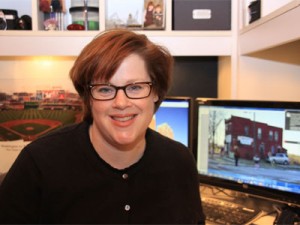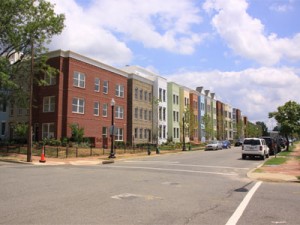When Jacqueline Dupree snapped a few photos of her neighborhood back in 2003 and posted them on her personal blog, little did she know that seven years later JDLand.com would be DC’s go-to site for all things Southeast. Her award-winning website has been compared to a historical archive, an urban planning document and even a time travel machine.
We had the opportunity to talk with “JD” about the neighborhood’s evolution, the real estate impact of Nationals Park, the soon-to-open Park at the Yards and more.
Thanks for joining us, Jacqueline. When JDLand won the Knight-Batten Citizen Media Award in 2008, judges described your blog as “an incredible wealth of information, especially impressive for a one-person effort.” What motivated you to start such an in-depth blog about this neighborhood and what keeps you going?
I wish I could say I started with a grand plan to obsessively document a changing neighborhood, but really all that happened was that I had been hearing in the early 2000s about changes that might be coming to the area south of the Southeast Freeway, so I decided I wanted to take some photos of what it looked like “before.” And in early 2003 I posted them on my personal blog at JDLand.com, mainly so that my parents (who lived the Hill in the 1950s and 1960s) could see them. Then I created a few web pages with information on the planned developments, so that I didn’t have to keep hunting down the links over and over. And then Google found me, and I found out that people were actually looking at my stuff for information. So I kind of puttered along, taking photos and posting information on the various plans until September 2004, when the city landed the Montreal Expos and decided to plunk down a stadium smack in the middle of the neighborhood I was tracking. And that’s when my site really took off, with the interest in the stadium and the accompanying rush of commercial real estate deals and plans, and I felt the need to document it all as thoroughly as possible. Emphasis on the “thoroughly.”
 After the stadium opened, it took me a while to recover from the ridiculous amount of time I had put in during the run-up to Opening Day, but that was made somewhat easier by the downturn in the economy and the commercial real estate market, since the volume of news dropped off considerably. I’ll admit to times when I’ve come close (*very* close) to shutting things down, but now for the most part I’m glad to have this still be part of my daily routine, although I have dialed back the intensity somewhat to keep myself from going insane.
After the stadium opened, it took me a while to recover from the ridiculous amount of time I had put in during the run-up to Opening Day, but that was made somewhat easier by the downturn in the economy and the commercial real estate market, since the volume of news dropped off considerably. I’ll admit to times when I’ve come close (*very* close) to shutting things down, but now for the most part I’m glad to have this still be part of my daily routine, although I have dialed back the intensity somewhat to keep myself from going insane.
You recently started a regular blog feature called “Rearview Mirror” that looks back at the Near Southeast neighborhood over past decades. For people who’d never set foot in this area prior to the baseball stadium, what are some interesting things to know about its past?
The neighborhood for most of its previous existence was mainly tied to the Washington Navy Yard, which at one time ran past its current boundaries all the way to First Street, SE (next to Nationals Park). There were always a lot of industrial uses in the area, and the housing stock was not particularly grand. The construction of the Southeast Freeway in the mid-1960s then served to really cut it off from Capitol Hill, and most people in the 1970s, 80s, and 90s would only have known of the area if they frequented the various gay and straight nightclubs that had settled in to many of the warehouses, or if they paid close attention to the woes at the Capper/Carrollsburg housing project, which was the scene of a fair amount of violence during the “crack wars” era. You hate to use a trite phrase like “forgotten neighborhood,” but in a lot of ways, it really was, especially given its proximity to the US Capitol. But, in a city where developers can’t build really tall buildings, land will always be at a premium, and Near Southeast’s location meant it was being eyed for redevelopment for many years, but the arrival of the stadium accelerated that process considerably.
I was lucky enough to begin taking photos before the vast majority of the demolitions happened, so I’ve able to document more than 160 buildings that have met the wrecking ball in the past 10 years. There aren’t many neighborhoods anywhere in the US that have recently been so completely transformed in such a short period of time.
I’ve only just started the Rearview Mirror series, and haven’t posted as many of those entries as I’d like, but I think longtime residents of Washington like me will have the same reaction I’ve had to some of the stories I’ll be posting–“Wait, that happened THERE?” I was embarrassed to discover that the building I’d known only as the Nexus Gold Club at New Jersey Avenue and I Street had in its previous days been the Chapter III nightclub, site of a brutal execution in the middle of First Street tied to Rayful Edmond III as well as a number of other violent deaths. I’ll be writing more about that, and other items, in the coming months. My focus will probably be more on the last 40 years of the neighborhood’s past, though–I’ll leave the documenting of the really old stuff to the pros.
What’s the biggest misconception about Near Southeast/Capitol Riverfront? How does your blog seek to overcome it?
I think perhaps the metro area is finally figuring out that Nationals Park is only about a mile from the US Capitol–for the first few years, I lost count of the number of times I’d link to a story that had some reference to the stadium being in Anacostia, which is on the other side of the Anacostia River. Now I just have to concentrate on publicly shaming anyone who talks about the ballpark being in Southwest and not Southeast.

I’d say the only other big misconception is that the neighborhood may be a bit dicey in terms of safety, which is left over from the higher crime that the area saw when it was home to a grittier lineup of small businesses than is the case today and before the Capper/Carrollsburg public housing began being redeveloped. I run an interactive map on my site showing all the crimes by year (since 2005), and, while it’s not crime-free, it’s nothing compared to the late 1980s and 1990s. But that can be said about most of the city.
What impact has Nationals Park had on residential real estate in the area? What are the current real estate trends?
Probably the biggest impact that the arrival of the stadium had on residential real estate was to speed up the timeline for new construction, as developers scrambled to snap up any available land north of the ballpark. On Opening Day 2008, there was one new multiunit building open (the Capitol Hill Tower co-op). Now there’s one condo building (Velocity) and four apartment buildings. There’s also the townhouse development at Capitol Quarter and two new low-income seniors apartment buildings, but those had been on the boards before the city decided to locate the ballpark in Near Southeast. The apartment buildings are mostly filled, thanks partially to people wanting to live close to the Hill or the ballpark but also thanks to rents that were lower for new-construction units in this neighborhood compared to other close-in sections of the city. It will be interesting to see if that pricing difference narrows, especially if and when more retail and entertainment options start coming to the neighborhood.
What developments and other changes are you hoping to see soon in Near Southeast?
The next big “moment” for Near Southeast will be within the next few months, when the 5.5-acre Park at the Yards is scheduled to open along the banks of the Anacostia River, just two blocks from Nationals Park. Wide open lawns, a boardwalk along the river’s edge, water features, a dog run, a “light tower” piece of artwork, and some retail kiosks will be something that I think a lot of city residents will be interested in checking out. This will be followed in late 2011 or 2012 by Canal Park, which will cross three blocks with open spaces, a pavilion, and an ice rink in winter.
There’s plenty of commercial development on hold in the neighborhood, so it will be interesting to see whether some of those projects find funding and get started. It was quite a whirlwind of construction between 2006 and 2009, so maybe a bit of a breather hasn’t been a bad thing, but certainly the residents, the people who work in the offices along M Street, and baseball fans are all itching for retailers to figure out that they’re wandering around this new neighborhood with few places to spend their money.
Please share some of your neighborhood favorites.
– Favorite hole-in-the-wall restaurant
– Favorite restaurant if someone else is paying
– Best uncrowded place for a pre- or post-game beer
I’ll take these three together, because as of this time there’s really very little restaurant action to speak of near Nationals Park. Justin’s Cafe opened at First and L earlier this year, offering pizzas, sandwiches, and salads, but it’s as much a bar as a restaurant and often times you’re ordering your food at the bar. There’s Five Guys, Subway, Starbucks, and Sizzlin’ Express, and small offerings inside the Courtyard by Marriott, and “The Bullpen” across from the ballpark, but otherwise, that’s it within the neighborhood. Residents go to Barracks Row a lot, or to the restaurants by the Capitol South Metro station at 1st and D, SE, but within Near Southeast itself, the lack of sit-down dining options has the residents getting impatient.
– Best kept secret at Nats Park: The observation deck on the southeast corner of the stadium, up above First Base. Great views of the Anacostia, the Douglass and 11th Street Bridges, the Navy Yard, Poplar Point, the soon-to-open Park at the Yards, and the boats arriving at Diamond Teague Piers. My first time visiting that spot, when the stadium was about six months from opening, is still one of my favorite memories of my Near Southeast blogging career. You just have to kind of blur the concrete plant out of your line-of-sight.
– Favorite (other) DC blog: What, you want me to be blackballed from the cut-throat DC blogosphere by picking a favorite? I read a lot of blogs, starting with the ones for the “next-door” neighbors Southwest and Capitol Hill. There’s also Frozen Tropics for news of H Street NE, The Triangle for the Mt. Vernon Square area, the Bloomingdale Blog, The 42 for Mt. Pleasant, and Prince of Petworth. I also read Greater Greater Washington and Beyond DC for city-wide and region-wide planning and transportation news.




